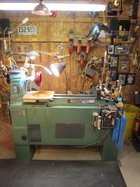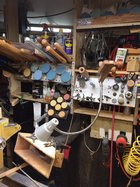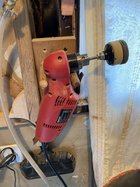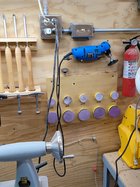-
It's time to cast your vote in the October 2025 Turning Challenge. (click here for details) -
Congratulations to Curt Fuller for "Bell Ornaments" being selected as Turning of the Week for October 27, 2025 (click here for details) -
Welcome new registering member. Your username must be your real First and Last name (for example: John Doe). "Screen names" and "handles" are not allowed and your registration will be deleted if you don't use your real name. Also, do not use all caps nor all lower case.
You are using an out of date browser. It may not display this or other websites correctly.
You should upgrade or use an alternative browser.
You should upgrade or use an alternative browser.
Milwaukee Drill/Sander
- Thread starter Richard Wilabee
- Start date
Here is a picture of a shelf I use to hold tools, sandpaper, power sander,etc. PM sent
Odie
Panning for Montana gold, with Betsy, the mule!
For those of you who are using the Milwaukee Drill as a sander what do you find is the best way to keep the drill at arms length when you need it. (Shelf, Hook, etc) Any pics would also help.
Rich
View attachment 7884
Rich.....I built a wall hanger for three angle drills, directly behind the lathe and on the wall......New model Milwaukee, old model Milwaukee, and Sioux. The hanger is simply a section of 2x4 with holes, dowel rods inserted and glued into the holes. I like to keep these sanders, and a variety of other frequently used tools at arm's length. After a time, I can really appreciate the convenience of having the drills handy. They remain plugged into the wall socket at all times.
I see you have the old/old style of Milwaukee angle drill/sander with the push/pull lever in the rear. I started out with the same drill, but with the Sioux name. Eventually the internal lever pivot points broke......had to make a jury-rig repair to it. Nothing wrong with the reversing switch.....it'll last for years, but the new/old style reversing switch is better. There are two speeds to these drills.....1200 and 2500 variable speed. I had a couple of the 2500rpm drills back in the day, but all I use now is the slower speed models.
The new style of Milwaukee drill/sander, in my opinion, isn't as good as the old style. It's the same outstanding 45° geared internal workings, but with a more modern looking plastic shell. It's ok for external sanding, but not as maneuverable as the old style, particularly with internal sanding of bowl walls that slant inward toward the center.
Attachments
Last edited:
Hi Rich,
I use a high-speed Sioux (2500 rpm). To keep it handy when finishing a turning I stick it on the lathe. I wrapped a rare-earth magnet with duck on the cord just past the stress relief. Supports the drill just fine.
I use a high-speed Sioux (2500 rpm). To keep it handy when finishing a turning I stick it on the lathe. I wrapped a rare-earth magnet with duck on the cord just past the stress relief. Supports the drill just fine.
Last edited:
Rich.....I built a wall hanger for three angle drills, directly behind the lathe and on the wall......New model Milwaukee, old model Milwaukee, and Sioux. The hanger is simply a section of 2x4 with holes, dowel rods inserted and glued into the holes. I like to keep these sanders, and a variety of other frequently used tools at arm's length. After a time, I can really appreciate the convenience of having the drills handy. They remain plugged into the wall socket at all times.
I see you have the old/old style of Milwaukee angle drill/sander with the push/pull lever in the rear. I started out with the same drill, but with the Sioux name. Eventually the internal lever pivot points broke......had to make a jury-rig repair to it. Nothing wrong with the reversing switch.....it'll last for years, but the new/old style reversing switch is better. There are two speeds to these drills.....1200 and 2500 variable speed. I had a couple of the 2500rpm drills back in the day, but all I use now is the slower speed models.
The new style of Milwaukee drill/sander, in my opinion, isn't as good as the old style. It's the same outstanding 45° geared internal workings, but with a more modern looking plastic shell. It's ok for external sanding, but not as maneuverable as the old style, particularly with internal sanding of bowl walls that slant inward toward the center.
Odie this one is the 0-1300 version. When I bought it I never thought I would be sanding bowls with it.
Last edited:
- Joined
- Feb 6, 2010
- Messages
- 3,420
- Likes
- 2,503
- Location
- Brandon, MS
- Website
- threeringswoodshop.square.site
I have mine (some generic) hanging on a single peghook. I just happen to have a small section of pegboard (really don't care for the stuff) at the lathe But I like Odie's better.
Odie
Panning for Montana gold, with Betsy, the mule!
Odie this one is the 0-1300 version. When I bought it I never thought I would be sanding bowls with it.
I was relying on memory......yeah, it's the 1300rpm version.
Actually, as Mark indicates....the 2500rpm will also work, but the lathe rpm needs to be adjusted to have approximately identical surface speeds. For me, the 1300 rpm works better, but either speed angle drill will work.
ooc
Steve Worcester
Admin Emeritus
I use an old Sioux right angle, but the same idea. I have a Sanders light stand (now Oneway) that hangs off the backside of the lathe. I drilled and tapped an opened up eye hook and it hangs neatly from it between the chuck and the Skilton sanding pad.
Because I don't like doing a long reach across my lathe bed for tools, I made a drill stand to hold my drills. I attached the stand to the side wall.
Have fun. Stay safe.
Have fun. Stay safe.
Shelf underneath the lathe for both the vac pump and the Niko right angle drill.
I was thinking I needed a hook of some sort, but haven't gotten around 2 it yet. Most of the time I just lay it down in my sanding hood, Which is about 2/3 of a 55 gallon white plastic food grade drum., as long as the dust is not too deep.
robo hippy
robo hippy
I haven't yet started using it, but I plan on using one of these to hold it up above the lathe:

I bought 5 of them to use with sanders and other light weight hand power tools. (not at the lathe).

Aero-Motive GM31 Tool Positioner Tension Adjustment Cable W Hook #4030L3IAC | eBay
Find many great new & used options and get the best deals for Aero-Motive GM31 Tool Positioner Tension Adjustment Cable W Hook #4030L3IAC at the best online prices at eBay! Free shipping for many products!
www.ebay.com
I bought 5 of them to use with sanders and other light weight hand power tools. (not at the lathe).
Odie
Panning for Montana gold, with Betsy, the mule!
Rich.....I built a wall hanger for three angle drills, directly behind the lathe and on the wall......New model Milwaukee, old model Milwaukee, and Sioux. The hanger is simply a section of 2x4 with holes, dowel rods inserted and glued into the holes. I like to keep these sanders, and a variety of other frequently used tools at arm's length. After a time, I can really appreciate the convenience of having the drills handy. They remain plugged into the wall socket at all times.
I see you have the old/old style of Milwaukee angle drill/sander with the push/pull lever in the rear. I started out with the same drill, but with the Sioux name. Eventually the internal lever pivot points broke......had to make a jury-rig repair to it. Nothing wrong with the reversing switch.....it'll last for years, but the new/old style reversing switch is better. There are two speeds to these drills.....1200 and 2500 variable speed. I had a couple of the 2500rpm drills back in the day, but all I use now is the slower speed models.
The new style of Milwaukee drill/sander, in my opinion, isn't as good as the old style. It's the same outstanding 45° geared internal workings, but with a more modern looking plastic shell. It's ok for external sanding, but not as maneuverable as the old style, particularly with internal sanding of bowl walls that slant inward toward the center.
Since my original post here in 2014, I have added a fourth drill. I don't mind changing discs, but with these standard Milwaukee chucks that require a key are a bit of a hassle to continually change mandrels. There are two drills with 3" mandrels, and two with 2" mandrels. (cut down mandrel diameters work much better for negotiating tight curves, so that's why there are two of each. The full sized diameter mandrels work best with flatter surfaces, or gradual curves.)
-----odie-----

Odie
Panning for Montana gold, with Betsy, the mule!
I was thinking I needed a hook of some sort, but haven't gotten around 2 it yet. Most of the time I just lay it down in my sanding hood, Which is about 2/3 of a 55 gallon white plastic food grade drum., as long as the dust is not too deep.
robo hippy
Hello Robo
I wouldn't mind seeing a photo of your sanding hood workstation.....if you have one handy.
-----odie-----
- Joined
- Feb 6, 2010
- Messages
- 3,420
- Likes
- 2,503
- Location
- Brandon, MS
- Website
- threeringswoodshop.square.site
I use the Roloc system from Ken Rizza and it has reduced all that wearing H&L pads out changing sandpaper.Since my original post here in 2014, I have added a fourth drill. I don't mind changing discs, but with these standard Milwaukee chucks that require a key are a bit of a hassle to continually change mandrels. There are two drills with 3" mandrels, and two with 2" mandrels. (cut down mandrel diameters work much better for negotiating tight curves, so that's why there are two of each. The full sized diameter mandrels work best with flatter surfaces, or gradual curves.)
-----odie-----
Odie
Panning for Montana gold, with Betsy, the mule!
I use the Roloc system from Ken Rizza and it has reduced all that wearing H&L pads out changing sandpaper.
Interesting, Gerald......
I was unaware of the roloc system by 3M, so looked for a demo on YouTube:
-----odie-----
- Joined
- Feb 28, 2021
- Messages
- 1,725
- Likes
- 1,539
- Location
- Roulette, PA
- Website
- www.reallyruralwoodworks.com
Yup. auto mechanics & auto body techs (like I was long ago) would be very familiar with Roloc pads, they were one of the best for stuck-on gasket removal, just had to be careful using roloc pads around soft metals, as they'd gouge into what should be perfectly flat (within half a thou) heads....Interesting, Gerald......
I was unaware of the roloc system by 3M, so looked for a demo on YouTube:
View: https://youtu.be/zoEh3sq_s1U
-----odie-----
So I was very quick to grab some when I found the changeable sanding pads (I was actually looking for "flap disks" - what they call Green Wave over at WW.) Then I went and got a whole "set" in both one inch and 2 inch , and absolutely love them - combined with green wave pads makes sanding go much faster especially through bottom transitions. Made a set of drawers that hold spare paper , and a pad for each grit, so as I sand through the grits, all I have to do is twist off one pad, pop it in its drawer, grab the next grit up in the drawer beside it, all the way from 80 (which I hardly ever start with any more as my tool control has improved) up to 600 grit. I actually though most everybody on AAW had heard of it.
Odie
Panning for Montana gold, with Betsy, the mule!
I've been using the 3M powerlock discs for a long time now....and, am very satisfied with this system.
I only use power sanding for interiors exclusively. On interiors, I use 60,80,100,120 and 150 powerlock discs, and then transition to hand sanding, starting at 180, up to 600.
(For exteriors, I do nothing but hand sanding starting at 180, if I need it.....and usually on up to 600gt.)
There are many different power sanding systems, and those from Ken Rizza look pretty good. All of these systems are good, and once you get started on any one system, you're likely to stick with it.....because you're invested in it at that point. Every system takes a certain learning curve, and acquired knack to get the best results.
I did try H&L discs for awhile.....and, I'll never go back to that system. The H&L fibers do wear out, quite often before the sanding material does.
-----odie-----
I only use power sanding for interiors exclusively. On interiors, I use 60,80,100,120 and 150 powerlock discs, and then transition to hand sanding, starting at 180, up to 600.
(For exteriors, I do nothing but hand sanding starting at 180, if I need it.....and usually on up to 600gt.)
There are many different power sanding systems, and those from Ken Rizza look pretty good. All of these systems are good, and once you get started on any one system, you're likely to stick with it.....because you're invested in it at that point. Every system takes a certain learning curve, and acquired knack to get the best results.
I did try H&L discs for awhile.....and, I'll never go back to that system. The H&L fibers do wear out, quite often before the sanding material does.
-----odie-----
- Joined
- Jul 18, 2018
- Messages
- 1,312
- Likes
- 2,811
- Location
- Baltimore, MD
- Website
- loujacobswoodturning.com
Odie, this is an old one, but I still use the drum, and the holder behind me shows how I keep my abrasive discs sorted. I am planning a new video about sanding, and my sanding station when I am using it. Oh, my articulated arm rest for when I am sanding.... This hood really works well.
View: https://www.youtube.com/watch?v=AZsVc7qVx7A
robo hippy
robo hippy
- Joined
- Feb 6, 2010
- Messages
- 3,420
- Likes
- 2,503
- Location
- Brandon, MS
- Website
- threeringswoodshop.square.site
@odie I should have put this video up as this is what I have in 2 and 3 inch with the hex shaft.
View: https://www.youtube.com/watch?v=aA0SSqSDfKM




